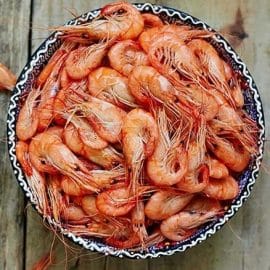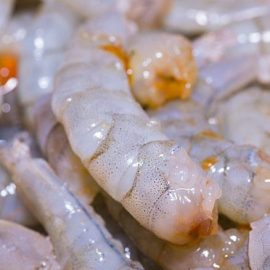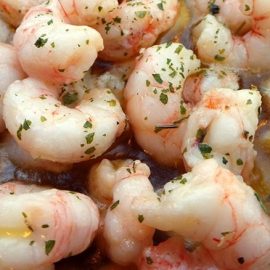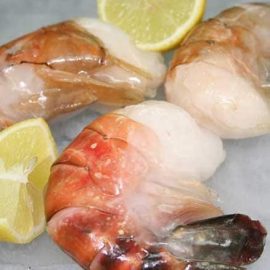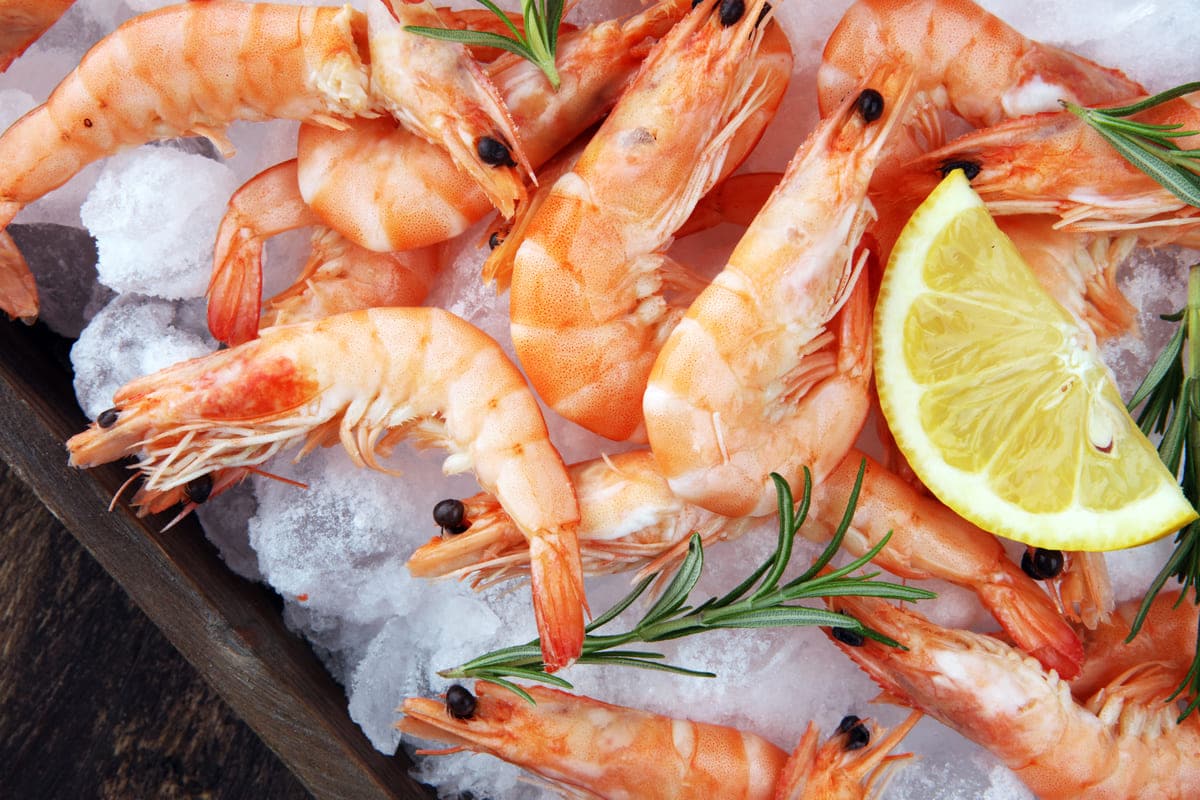
Introduction
Prawn is a type of decapod crustacean belonging to the order Decapoda. It is a member of the same family as shrimp but features a slightly larger body with a more pronounced curve from head to tail, a sweet aroma, and a firm but crunchy texture.
They play an essential part in many marine ecosystems and have also been utilised by humans for food and aquaculture, the aquarium and pet trades.
Description
Prawns are found in both fresh and salt-water environments all over the world. They are slightly larger than shrimps and have long, slender bodies with flexible abdomens and two pairs of walking legs to help them move. They also have a semi-rigid carapace, which is covered in setae.
Due to their high adaptability and excellent eyesight, prawns can quickly identify food sources. They measure between 3-15cm in length and can weigh up to 250g.
Most fresh prawns are reddish-brown but can also come in shades of yellow, brown, and black. Their outer shells are typically thin and range from transparent to smoky grey.
Prawns have a segmented body divided into a head and thorax region. The head has two pairs of antennae, the eyes, and several pairs of mouthparts. The thorax consists of 8 segments, and the abdomen consists of 5 parts which are home to their unique features such as the “plumose hairs” and gills called pleopods.
The prawn’s pointed head, oval eyes, miniature pinchers, and large claws help it move and capture its prey. These claws also act as a method of self-defence and communication.
Additionally, two to four pairs of swimmerets can be found on the ventral side of the abdomen. A swimmeret is an external appendage found on the underside of a prawn, which aids in locomotion while swimming and mating.
Habitat
Prawns prefer areas of warm, shallow, and slow-moving water with plenty of vegetation. They tend to inhabit estuaries, coastal bays, estuarine bays, rock pools, sandy bottom intertidal, and reef flats with waters that cover depths from 0-50 meters. They are most commonly found in shallow, coastal areas with plenty of food and shelter.
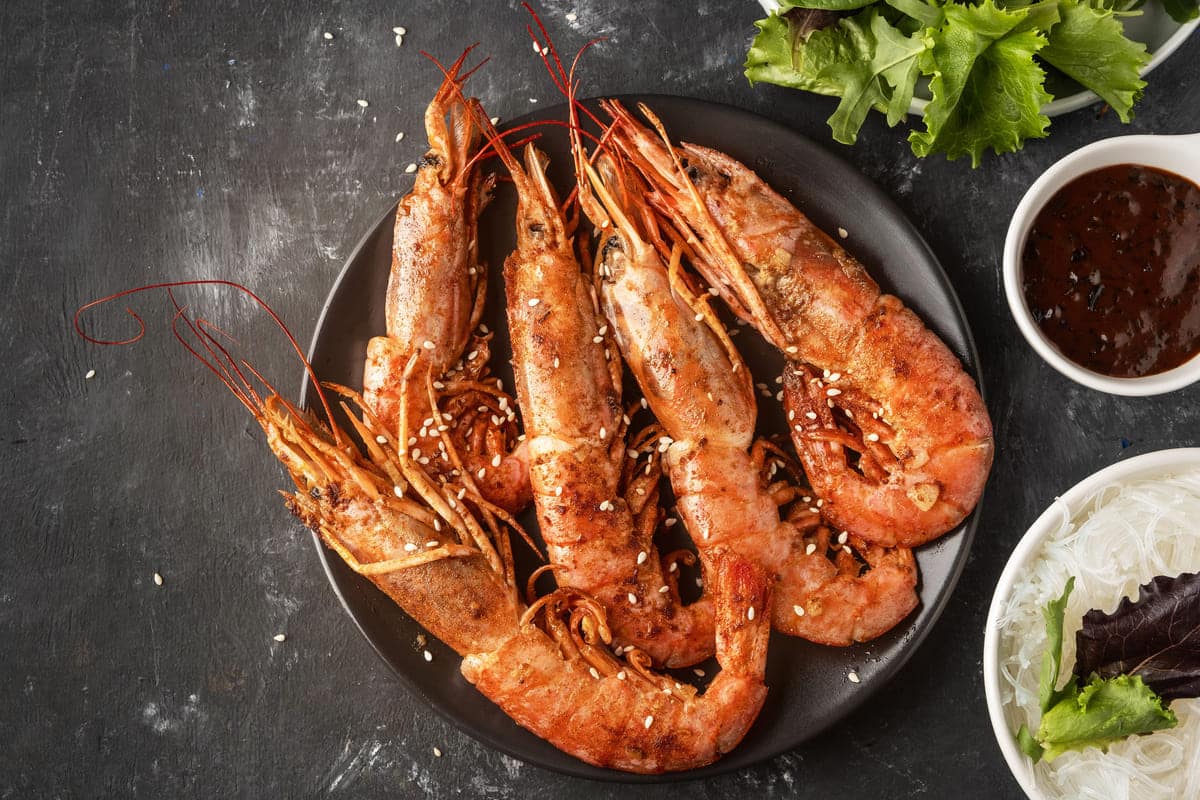
Prawn Fisheries
Prawns are an important and commonly harvested species internationally, providing nutritional benefits and other uses in many cultures. They are fished commercially, and their population is typically monitored and managed through government regulations and industry practices.
Types of Fishing Methods
Prawns are caught and harvested through various fishing techniques, the most common of which are trawling, seine netting, traplines, and dredging.
Trawling and seine netting involves dragging weighted nets through the water to capture large numbers of organisms at one time, while trap fishing involves baiting traps with food to catch prawns.
Dredging is also a method used to collect prawns. However, this technique is considered very destructive due to its impact on the seafloor.
Environmental Impact
The primary factor affecting the sustainability of prawn fisheries is bycatch. In areas where trawl and seine fishing are practised, bycatch of other marine species can significantly increase, resulting in an overall decrease in prawn stocks. Pollution from fishing fleets can also contribute to the destruction of fragile coastal habitats.
Industry Regulations
Governments of countries where prawn fisheries are carried out must maintain industry regulations that reduce environmental impact, improve resource management, and achieve sustainable yields. This will help protect the species’ future, ensuring the availability of prawns for years to come.
Fisheries Sustainability
The long-term sustainability of prawn fisheries is improved by implementing technologies and practices that reduce bycatch and environmental damage. Drones are often used to monitor and track fisheries, thereby decreasing the bycatch rate, while catch quotas can be employed to ensure sustainable stock levels.
Ultimately, responsible conservation and management of prawn fisheries are essential for the species’ future.
Distribution of Stocks
Prawns can be found in all temperate and tropical seas. In the United States, they can be found along the coasts of Florida, the Gulf of Mexico, and the western shores of California, Oregon, and Washington.
Prawns are also commonly found in Australian waters, with some populations located as far away as Southeast Asia and China.
Life Cycle of Prawns
The life cycle of prawns is species-specific and follows a generally accepted pattern. Most prawn species have an indirect life cycle, beginning with the hatching of free-swimming larvae from eggs released into the water.
The larvae swim and feed for about 3-4 weeks; after this, they shed their skin and become post-larvae (juveniles). The juveniles then move near the surface before eventually settling into shallow waters and transforming into adults. Adult prawns live for a few months to a year, depending on the species, and once fully grown, they can mate and spawn, thus beginning the cycle anew.
The life span of a prawn can range from several months to a few years, with Australian deep-sea prawns living for up to five years. During spawning and hatching, prawn eggs develop into nauplii before undergoing several instar stages as they grow. Once they have reached the juvenile stage, they shed their exoskeleton to transition into adulthood and eventually reproduce.
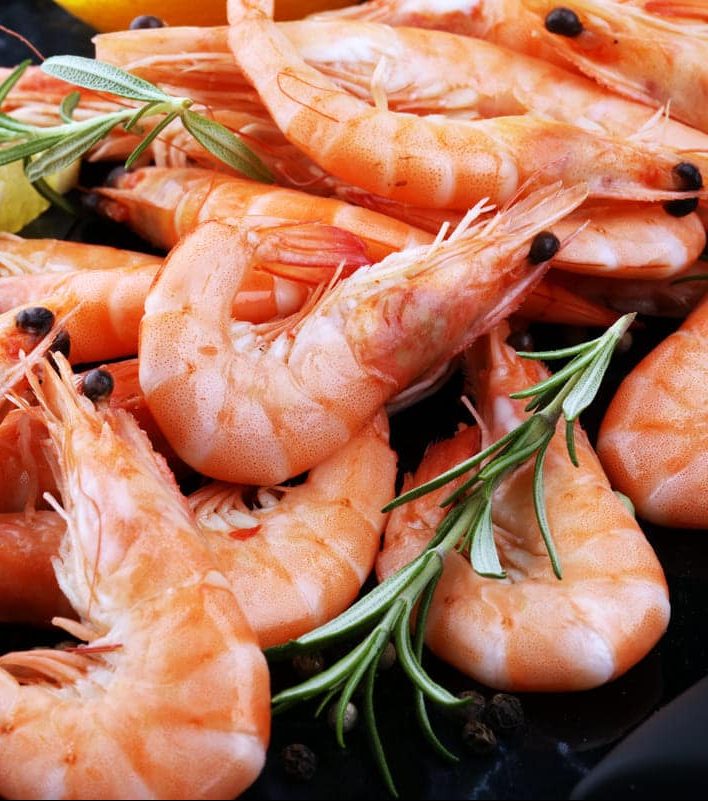
Adaptability
Prawns are well-suited to a range of salinity and oxygen levels and can survive in various habitats. They dig burrows or occupy crevices in the sand to stay protected from predators. Prawns are essential to maintaining the stability of many natural ecosystems through their exoskeletons, breeding cycles and burrowing habits.
Prawn’s Diet
Prawns are omnivorous animals, meaning they feed on plant and animal matter. Their primary diet consists of algae, zooplankton, living and decaying organic matter, aquatic plants, other invertebrates, and occasionally small fish.
As foraging animals, they use their antennae and legs to locate and identify potential food sources by sensing chemicals in the water, scavenge for leftovers from other organisms, and capture prey such as small crustaceans and insects and other small invertebrates and fish fry, also using their chelipeds.
In addition to these animal sources, prawns will feed on the phytoplankton and detritus in their environment, harnessing energy and nutrients.
Importance to Ecosystems and Humans
Prawns play an essential role in local aquatic environments as predators and prey. They are also of considerable economic and social value to humans worldwide. In recent decades, aquaculture has rapidly grown, with prawns being among the most commonly cultured species. The sustainable management of prawn stocks is essential in fisheries management and conservation.
Uses and Popularity
Today, prawns remain a popular seafood choice in many nations, including Europe and India, where they are typically consumed in fresh and frozen forms. Prawns are also featured in various dishes, from traditional curries and stir-fries to exotic sushi platters and gourmet meals. In multiple cultures, prawns are revered for their varied tastes and textures, making them a favourite among seafood lovers worldwide.
Nutritional Benefits
Prawns are highly nutritious seafood, containing a range of essential vitamins and minerals. They are a great source of protein, helping to maintain muscle mass and sustain energy levels.
Vitamins in Prawns include Vitamin A, B6, B12, C, D, E and K. They contain minerals such as potassium, phosphorus, zinc, magnesium, selenium, iron, and calcium.
Omega-3 fatty acids found in Prawns are incredibly beneficial, helping to reduce inflammation, lower cholesterol levels, and reduce the risk of developing certain cancers.
Additional Health Benefits
Vitamin B12 has many beneficial effects on cardiovascular health, helping reduce stress and improve cognitive function. Furthermore, Prawns contain natural iodine, which works to maintain a healthy metabolism. On top of this, Prawns offer a low-fat, low-calorie alternative, making them the perfect choice for a balanced diet.
Versatility
Prawns, also known as shrimp, are one of the world’s most popular and versatile seafood options. Whether used in stir-fries, paellas, curries, and risottos, the unique flavour and pleasing texture of prawns provide a delicious seafood choice in various dishes from around the globe.
Flavor and Texture
Prawns have a delicate, sweet flavour with a crunchy texture that is enjoyed when cooked.
The flavour of prawns can be enhanced easily by marinating, grilling, or using a selection of herbs, spices and citrus fruits such as butter, lemon, garlic, rosemary, thyme, oregano, basil, dill, paprika, cumin, curry powder, black pepper, garlic powder, lemon, lime, and orange.
Dietary and Culinary Uses
Prawns are widely used worldwide for their sweet and delicate flesh, light pink colour, slightly nutty flavour, and firmer texture when cooked.
Prawns are categorised according to their size: small, medium, and large. They are often used in stir-fries, salads, soups, tempura, sushi, and other dishes. Some popular prawn dishes include sautéed prawns, prawn tempura, and boiled or poached prawns.
Cleaning and Deveining before Cooking
Cleaning a prawn involves rinsing off and removing debris from the shell, body and tail. Particular attention should be paid to trimming away any spiny horns or antennae with kitchen scissors.
Shells may then be peeled away by cutting carefully along the back of the prawn.
The black vein or ‘rust-line’ is found down the back of a prawn and should be removed to avoid an undesirable taste. To devein, use a paring knife, gently insert it into the back of the prawn, and cut along the length of the body cavity. Lastly, rinse and dry the prawns on a paper towel.
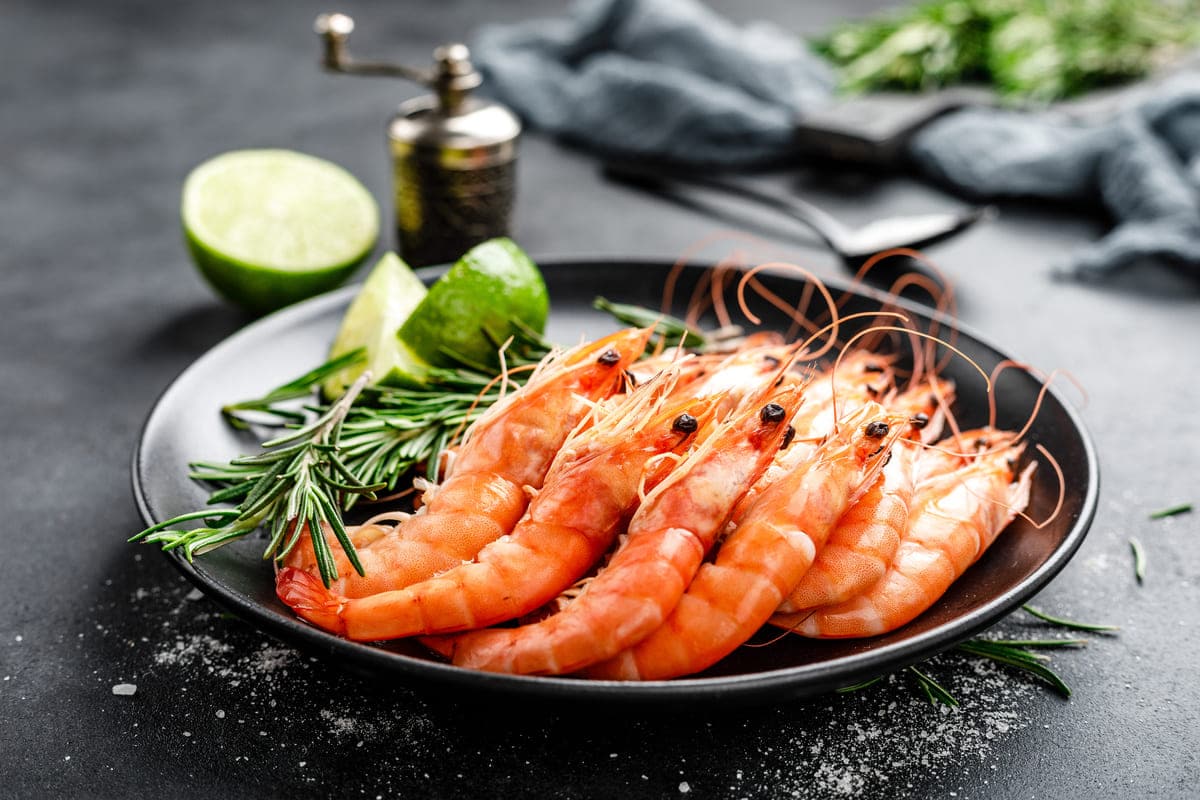
Cooking Techniques
Once cleaned and prepped, prawns can be cooked in an array of tasty ways. Some popular options include boiling, steaming, sautéing, bbq, grilling, poaching and deep-frying in high heat.
Many chefs add marinades, dips, and batters to cook prawns for added flavour and texture enhancement. A “Butterfly Technique” is also available, which involves carefully slicing the prawns lengthwise from the tail to the head before peeling away the shells. The prawn can then be flattened lightly with the heel of your hands for even cooking.
Accompaniments & Other Ingredients
Side dishes are an essential part of tasting and enjoying prawns. Some popular side dishes that pair well include various types of rice, such as jasmine and basmati; fresh or roasted vegetables, such as asparagus, bell peppers, and onions; creamy sauces, such as garlic and basil; and refreshing salads, such as Greek, quinoa, or Caesar. Roasted potatoes, such as new potatoes, sweet potatoes, or Yukon golds, also provide a great flavour and texture contrast.
Rich and creamy sauces such as beurre blanc, buttery garlic sauce, or a rich cream sauce can be added for extra flavour and complexity. Juicy prawns also pair well with bread, pasta, squash, tomatoes, and mushrooms.
Adding sweetness to a prawn dish is easier than it may sound. Fruits such as mango, pineapple, or other sweet fruits, as well as sweet sauces like honey mustard and teriyaki sauce, can all be used to add a precious element to the dish. For a full plate, prawns can also be served alongside grilled meats or fish.
Making the Most of Flavor Profile
Complementary ingredients and flavours can enhance the flavour profile when cooking with prawns. Fresh lemons and limes can help to brighten the taste of the prawns. At the same time, herbs and aromatics such as garlic, onions, chillies, basil, oregano, and cilantro offer an extra flavorful kick.
For an umami-rich touch, recipes may call for fish sauce, anchovies, olives, and Parmesan cheese, while marinades, infused oils, brines, and pickles provide a wide variety of flavour options.
Quick and Easy Recipes
For those who are time-strapped, quick and easy recipes can be made with prawns, too. Sautéed prawns with garlic and chilli, spicy tacos with slaw and avocado, prawn and chorizo skewers with bell peppers, and sheet-pan prawns with lemon and herbs can be made in no time.
More exotic dishes, such as Thai Red Curry with vegetables, coconut milk, prawns, and prawns on toast with spicy mayo, can be tantalisingly quick when made with pre-made sauces and pastes.
Popular Dishes
Prawns can be served warm (i.e. boiled or grilled) or chilled, sautéed, breaded, batter-fried, and in hors d’oeuvres.
Popular dishes highlighting this seafood include traditional prawn cocktails, shrimp vindaloo, Massaman Curry, stir-fried Prawns, lettuce wraps, grilled Prawns, and fried Prawns. A generous amount of seasoning, marinating, or cooking with butter will bring out the full flavour of prawns. For best results, prawns should be cooked with the shell on to lock in the natural juices and flavours.
Conclusion
Prawns have been a part of society since the dawn of civilisation. Whether used as a source of income, a symbol of good luck, or a nutritional staple, they have been a crucial part of many cultures, particularly those of Central and South America, Europe, Asia, and the United States.
Over a billion people rely on prawns for their food because they are highly nutritious and versatile fish.
In this modern age, Prawns are now widely sought after and available, thanks to advances in globalisation and industrialisation, making them an essential part of many cultures’ culinary traditions.

